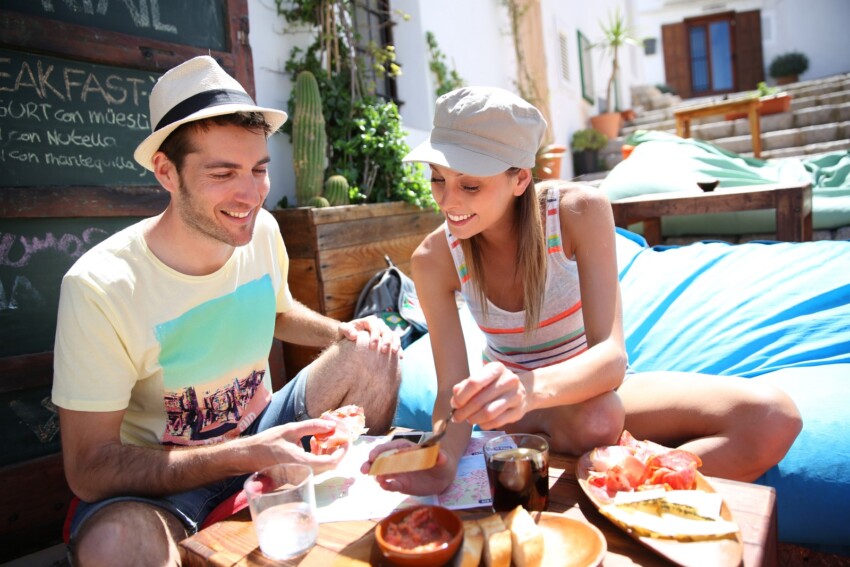

A holiday in Spain is a true feast of taste: the Spanish love to eat well and food plays a major role in social life. Spanish cuisine is very rich and varied: each region has its own food and wine tradition, with local specialities prepared with the freshest local ingredients.
This thousand-year-old gastronomic tradition has its roots in the fusion of different cultures: the Roman heritage with its olive oil cult, the Arab influence with its spices and irrigation techniques that revolutionised agriculture, and the contribution of the New World that brought fundamental ingredients such as tomatoes and potatoes. Today, this rich heritage manifests itself in a cuisine that is both deeply traditional and surprisingly innovative.
From the pescado frito of the Mediterranean coast to the hearty cocidos of the hinterland, from Valencian paella to refined Basque cuisine, Spain offers a gastronomic panorama of extraordinary richness. The Spanish culinary philosophy is based on an almost reverential respect for seasonal ingredients and the conviviality of the shared meal, elements that find their highest expression in the tapas culture. It is not just about food, but a true lifestyle that emphasises sociability and the pleasure of eating together.
Here is our guide to what to eat in Spain. Be warned, however, that reading this guide will make your mouth water!
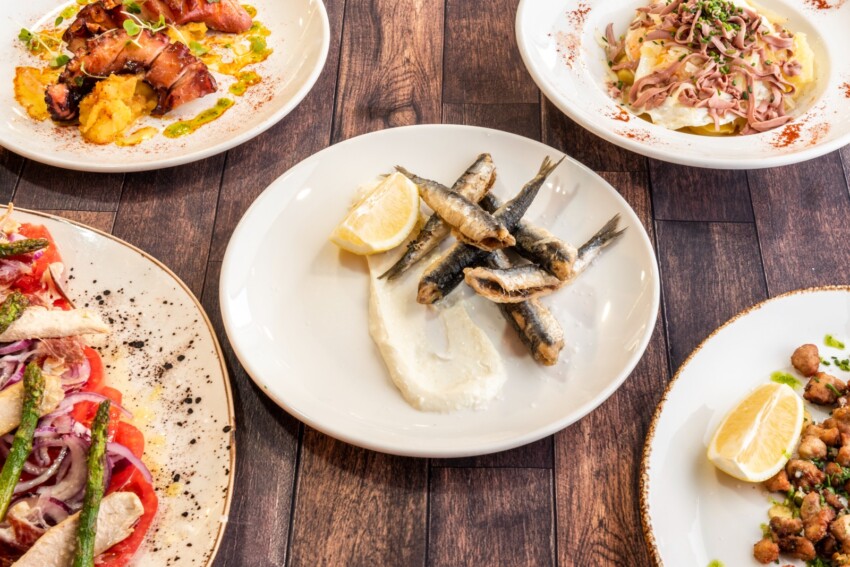
Tapas represent the very essence of Spanish sociality, a cultural phenomenon that transcends the simple act of eating to become a true social art form. Their history is shrouded in a fascinating mix of legend and tradition: it is said that the term derives from the ancient custom of covering (‘tapar’) wine glasses with slices of bread or ham to protect them from dust and insects. According to another version, it was King Alfonso X the Wise who decreed that in taverns wine should always be served with small portions of food, to prevent patrons from getting drunk too quickly.
Today, tapeo (the art of going from bar to bar eating tapas) has become a social ritual that punctuates Spanish evenings. In the lively streets of Madrid, the neighbourhoods of La Latina and Chueca teem with places where traditional tapas are reinvented with creative touches. Patatas bravas with their spicy sauce, pimientos de padrón (small fried green peppers), and croquetas de jamón are just the beginning of a gastronomic adventure that can last for hours.
In Andalusia, a land of millennial traditions, tapas take on a more austere but no less refined character. In the bars of Seville, jamón ibérico de bellota is cut by hand with the precision of a surgeon, while in Granada they keep alive the ancient tradition of serving a free tapa with every drink ordered. Cadiz’s gambas al ajillo (garlic prawns) and Málaga’s pescaíto frito (fried fish) are perfect examples of how simple ingredients can be transformed into small gastronomic masterpieces.
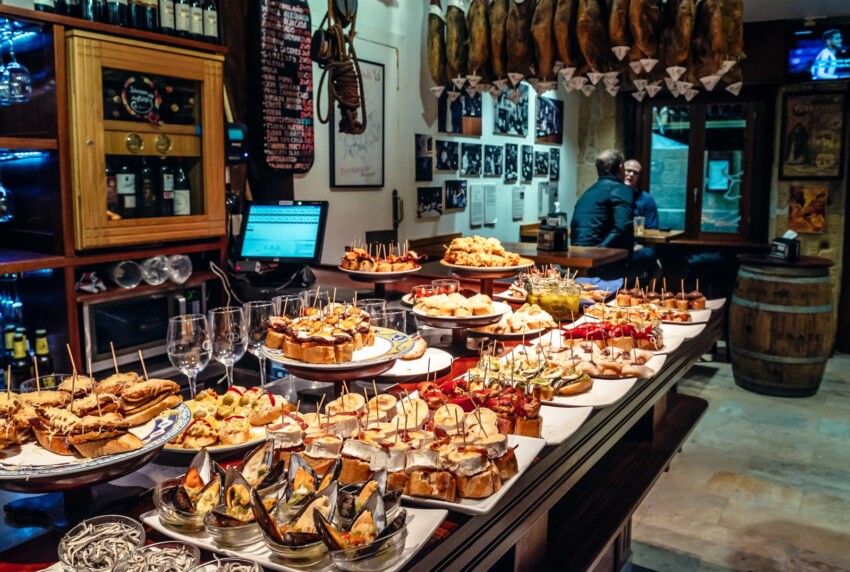
In the País Vasco, tapas culture reaches its evolutionary peak with pintxos. In San Sebastián, considered by many to be the gastronomic capital of Spain, the bar counters of the Parte Vieja are transformed into miniature showcases of haute cuisine. Here, chefs compete in creativity, turning each pintxo into a small work of culinary art: from the traditional Gilda (a pintxo that combines anchovy, olive and chilli) to more innovative creations that incorporate molecular cooking techniques. The tortilla de bacalao at Bar Nestor and the carrillera de ternera (braised beef cheek) at La Cuchara de San Telmo have become gastronomic pilgrimages.
In Barcelona, the concept of tapas merges with Catalan modernity. In the Born and Raval, traditional tapas are reinterpreted with an avant-garde twist: pa amb tomàquet becomes the basis for innovative creations, while montadito de butifarra celebrates the Catalan charcuterie tradition. Huevos rotos con chistorra and bombas (spicy stuffed potato balls) have become symbols of Barcelona’s gastronomic scene.
The evolution of tapas perfectly reflects the transformation of Spanish cuisine as a whole: deeply rooted in tradition but always ready to innovate, respectful of ingredients but open to experimentation. Whether a humble boquerón en vinagre (marinated anchovy) or a sophisticated modern creation, tapas remain the most authentic way to explore the gastronomic soul of Spain, one bite at a time.
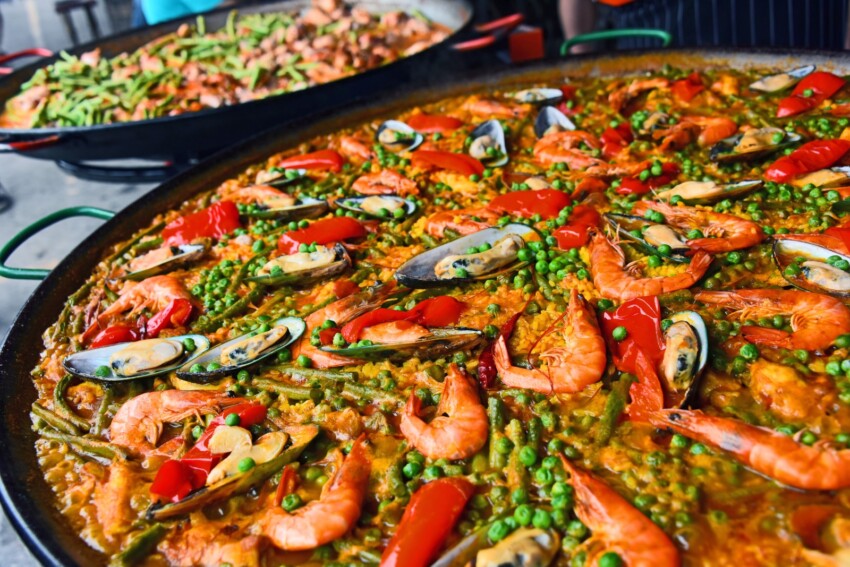
In the vast panorama of Spanish gastronomy, some dishes stand out as true culinary icons, witnesses of a centuries-old tradition that continues to enchant the most demanding palates. Among them, the Valencian paella occupies a place of honour: born in the Valencia countryside, it is much more than a simple rice dish. The authentic version, prepared with chicken, rabbit, snails, green beans and carroffa, tells a story of peasant flavours elevated to art. It is a Sunday ritual that brings families together around the table at lunchtime – never at dinner, as tourist restaurants would have it – and whose aroma of saffron and rosemary has become the very symbol of Spanish conviviality.
When the midday sun beats down on the streets of Andalusia, gazpacho becomes a lifesaver. This cold soup, born of folk wisdom, transforms ripe tomatoes, peppers, cucumbers and garlic into a refreshing elixir that encapsulates all the flavours of the Mediterranean garden. Its fuller-bodied cousin, salmorejo cordobés, enriched with hard-boiled egg and jamón flakes, represents the mouth-watering evolution of this tradition, a comfort food that has conquered the entire peninsula.
The tortilla española is perhaps the dish that best embodies the soul of Spanish home cooking. This apparently simple potato and onion omelette hides a world of techniques and preferences that divide Spaniards: some want it ‘jugosa’, with a creamy heart that almost drips onto the plate, and others prefer it well cooked, with a more compact texture. Each family has its own secret recipe, handed down from generation to generation, and each bar prides itself on serving the best in town.
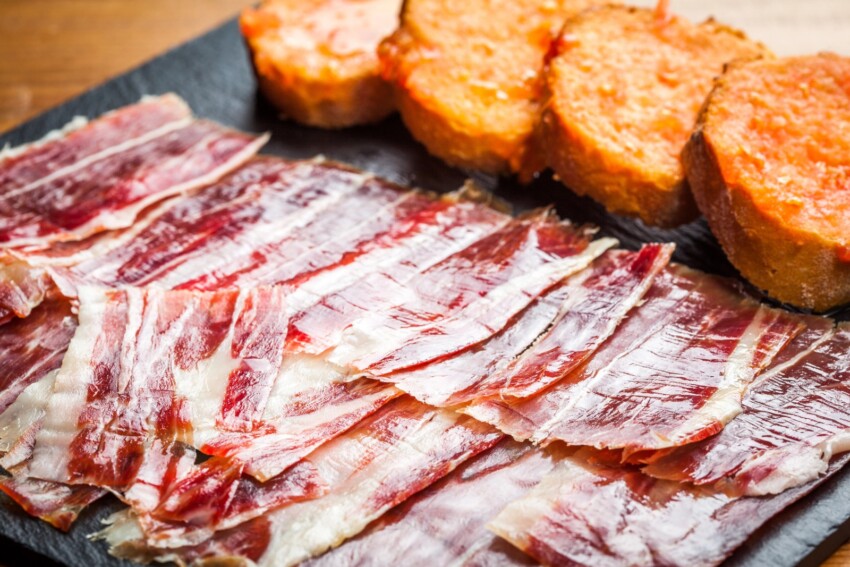
Jamón ibérico de bellota represents the pinnacle of Spanish charcuterie art. Produced from the prized black Iberian pigs, raised in the wild and fed mainly on acorns in the dehesas of the interior, this ham requires curing for up to 48 months to develop its characteristic complex and enveloping flavour. Watching it being hand-cut by a jamonero master is a spectacle that turns tasting it into an almost mystical experience.
In the colder months, Asturian fabada warms the body and soul of diners in Asturias. This opulent white bean stew, enriched with various pork preparations – from spicy chorizo to spicy morcilla and smoked bacon – is the emblem of the hearty cuisine of northern Spain. Similarly, the cocido madrileño represents the gastronomic pride of the capital: traditionally served in three ‘vuelcos’ (courses), it transforms lunch into a ritual that can last hours, where broth with noodles precedes chickpeas with vegetables, culminating with the meat that has yielded its flavour to the whole.
From the sea come dishes with extraordinary personality, such as calamares en su tinta, where the squid ink is not just a dramatic colour but an element that gives the dish an intense, marine flavour, perfectly balanced. And for those seeking the essence of Spanish simplicity, huevos rotos represent the perfect synthesis: fried eggs served on a bed of crispy potatoes and ‘broken’ at the moment of serving, often enriched with slices of jamón or chorizo. A simple dish that encapsulates all the warmth of Spanish home cooking.
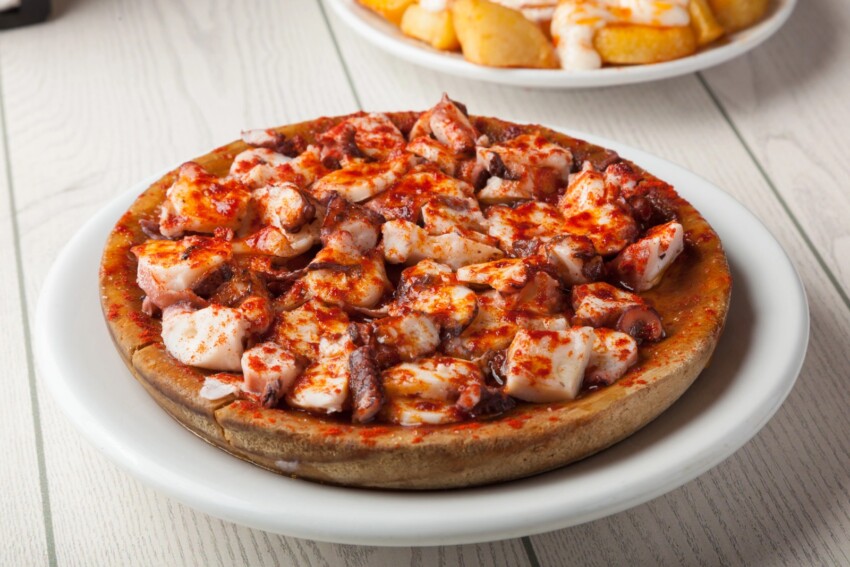
Spanish cuisine is very rich and varied: each region has its own food and wine tradition, with typical local specialities prepared with the freshest local ingredients.
Galicia, in the north-western corner of Spain, is a seafood paradise. Pulpo a la gallega (Galician-style octopus) is the emblem of the region: tender boiled octopus, seasoned with olive oil, paprika and coarse salt, served on a traditional wooden platter. Grilled vieiras (scallops), often served in their shell with a soft mashed potato base, are another iconic dish.
Percebes (barnacles) are considered a true delicacy: these uniquely shaped crustaceans are hand-harvested from the rocks pounded by the Atlantic waves, which justifies their high price. Don’t miss the chance to taste the local marisco in the lively restaurants of Santiago de Compostela or in the ports of Vigo and A Coruña.
Galicia is also a land of excellent beef. Hot gallego, a hearty soup of vegetables, beans and pork, is the perfect comfort food during the rainy days typical of the region.
The Basque Country is the epicentre of modern Spanish gastronomy. San Sebastián, with its extraordinary concentration of Michelin-starred restaurants, is considered one of the gastronomic capitals of the world. In traditional restaurants, bacalao al pil-pil is a must: cod prepared in an emulsified sauce of olive oil and garlic that requires a precise preparation technique.
Txuleta, a barbecued rib-eye steak, is another signature dish of the region, often served in typical asadores. The marmitako, a tuna stew with potatoes and peppers, bears witness to the maritime heritage of the Basque Country.
Catalonia boasts one of the most sophisticated culinary traditions in Spain. The concept of mar i muntanya (sea and mountains) is central: dishes such as chicken with shrimps or rabbit with snails perfectly represent this philosophy of combining land and sea ingredients.
Escudella i carn d’olla is the traditional Catalan dish par excellence: an elaborate soup served in two courses, first the broth with pasta and then the meat and vegetables used in its preparation. On the other hand, suquet de peix, a fish stew typical of the Costa Brava, represents the seafood tradition.
Andalusia is the cradle of many dishes that have become symbols of Spanish cuisine. Gazpacho and its thicker cousin, salmorejo, are the cold soups that have conquered the world. The province of Jaén produces some of the best olive oils in the world, while Jerez is famous for its fortified wines and pescaíto frito, a mix of crispy fried fish that has influenced cuisine throughout the Mediterranean.
Cadiz ‘s gambas al ajillo (garlic prawns) and Córdoba ‘s rabo de toro (bull’s tail) are other representative dishes of the region. The Malaga coast is famous for espetos, sardines grilled on bamboo poles right on the beach.
Although Valencian paella is the region’s most famous dish, Valencian cuisine offers much more. Arroz a banda (rice with fish), arroz negro (rice with cuttlefish ink) and fideuà (similar to paella but made with short pasta) are other unmissable specialities.
Valencia is also the home of horchata, a refreshing drink made from chufa (cyperus tubers), traditionally accompanied by fartons, sweet glazed rolls. The region is also famous for its oranges, used in numerous sweet and savoury preparations.
The two Castilles represent the soul of traditional Spanish cuisine. In Segovia, cochinillo asado (roast suckling pig) is so tender that it is traditionally cut with the edge of a plate. The lechazo (suckling lamb) from Castilla y León is equally renowned.
The sopa castellana (garlic soup with poached egg and ham) and cocido madrileño (chickpea stew with meat and vegetables) are hearty dishes that reflect the pastoral tradition of the region. Burgos is famous for its fresh cheese, while Ávila is renowned for its high-quality beef.
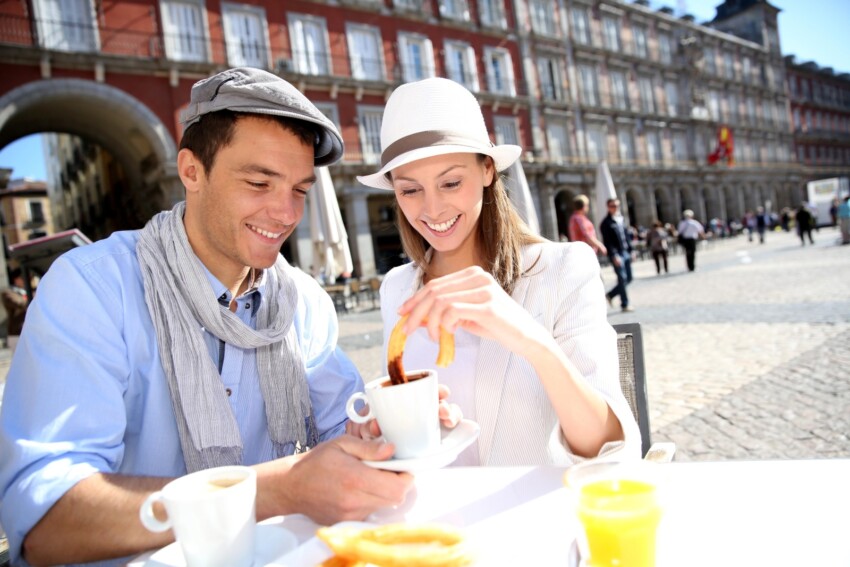
Spanish confectionery is a fascinating journey through centuries of history and tradition, where the Arab influence with its love of dried fruits and honey blends with Catholic convent recipes rich in eggs and sugar.
The world of Spanish sweets is rich and varied, with specialities that change from region to region and according to festivities. Churros con chocolate are a national institution: fried dough sticks to dip in thick hot chocolate, perfect for breakfast or as a late-night snack. Those with a sweet tooth cannot miss porras, a thicker, fluffier version of churros.
Creme Catalana, a cousin of the French crème brûlée, is distinguished by the addition of citrus peel and cinnamon, with a caramelised sugar crust that breaks at the touch of a spoon.
Mallorca’s ensaimadas are very light, spiral-shaped brioche, available plain or filled. In Santiago de Compostela, the tarta de Santiago with almonds and decorated with the characteristic cross is an absolute must.
The piononos of Santa Fe (Granada) are delicious sponge cake rolls soaked in syrup and crowned with toasted cream, while the Catalan xuxos are fried puffs filled with cream.
During the Christmas period, turrón reigns supreme in Spanish homes. This nougat is produced in numerous varieties, from the classic Jijona (soft) and Alicante (hard) to modern versions with chocolate or dried fruits.
In spring, especially during Holy Week, torrijas (similar to French toast) perfume pastry shops: slices of bread soaked in milk or wine, fried and topped with honey and cinnamon.
Spain has a rich tradition of dulces conventuales, sweets made in convents according to centuries-old recipes. The yemas de Santa Teresa de Ávila (egg yolk-based sweets), mantecados and polvorones are perfect examples of this tradition.
The new Spanish pastry, influenced by great pastry chefs like Jordi Roca, is reinventing traditional desserts. Chocolate con aceite y sal (chocolate with olive oil and salt) has become a new contemporary classic.
In the Spanish summer heat, turrón ice cream is a must, as is horchata granizado. The leche merengada, a dessert drink made of milk, cinnamon and meringue, is perfect for cooling down.
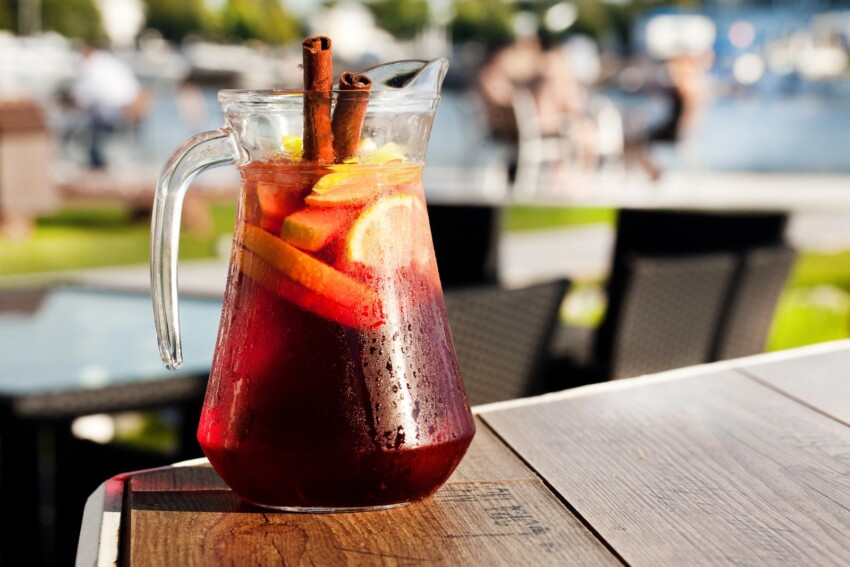
Spain’s wine and drink culture is as rich as its gastronomy. From the prestigious wine regions that produce some of the best wines in the world to the refreshing summer drinks that have conquered the international palate, each sip tells a story of territory, tradition and innovation.
Spain is a true wine lover’s paradise, with a thousand-year-old wine tradition expressed through 70 registered designations of origin (D.O.) and some of the most prestigious wine regions in the world. The variety of terroirs, climates and indigenous grape varieties creates a wine landscape of extraordinary richness.
Rioja, the undisputed queen of Spanish wine, produces some of the best reds in the world. Its wines, mainly based on the Tempranillo grape variety, are classified according to ageing: the Crianza (minimum two years, one of which in barrel), the Reserva (three years, one of which in barrel) and the prestigious Gran Reserva (minimum five years, two of which in barrel). Notes of vanilla and spices, due to ageing in American oak barrels, are the distinctive signature of these elegant wines.
The Ribera del Duero region, a great rival to Rioja, produces powerful and structured red wines, again from Tempranillo grapes (here called Tinto Fino). The extreme continental climate with large temperature fluctuations gives the wines a unique concentration and complexity.
In Catalonia, Priorat has gained an international reputation for its intense, mineral wines, produced from very old Garnacha and Cariñena vines on slate soils. In the same region, the Catalan cava, produced mainly in the Penedès area, represents Spanish excellence in bubbles. Made with the champenoise method and using indigenous grape varieties such as Xarel-lo, Macabeo and Parellada, it can rival the world’s best sparkling wines.
The Jerez (Sherry) of Andalusia is a world of its own. These fortified wines, produced with a unique ageing system called ‘solera’, offer an incredible range of styles: from the very dry Fino to the Manzanilla, from the complex Amontillado to the sweet Pedro Ximénez. Traditionally served as an aperitif or digestif, Jerez is experiencing a rediscovery thanks to its versatility in gastronomic pairings.
The Rías Baixas in Galicia is the realm ofAlbariño, an aromatic and mineral white wine perfect with the region’s seafood. While the Rueda region specialises in the Verdejo grape, producing fresh and fragrant whites that have become the most popular in Spain.
Cerveza is a constant presence in Spanish bars, always served very fresh and in several characteristic formats. The caña, the most popular format, is a small glass of draught beer (200ml) that ensures the beer always remains cold and lively until the last sip. The doble is the larger version of the caña (330ml), while the tanque is a half-litre mug, more common in breweries.
The Spanish have developed a real cult for temperature and beer tapping: the tirador (the person responsible for tapping) has to create the right amount of foam, called collarín, which protects the beer from oxidation and keeps it fresh. On warm summer evenings, it is common to find botellín (200ml bottles) served in chilled glasses or tercio (330ml bottle).
Popular national brands include Mahou, Estrella Damm and San Miguel, but in recent years a lively craft beer scene is emerging, especially in Madrid and Barcelona.
Cider, a little-known and little-appreciated drink in Europe, deserves a separate discourse. Instead, it is the drink par excellence in the regions of northern Spain. We highly recommend you try it if you visit the Basque Country and especially Asturias, a region where this alcoholic apple nectar is much loved and is served with a very special, almost acrobatic ritual that is worth a visit in itself to the traditional bars.
Sangria is a summer must, but Spaniards prefer tinto de verano (red wine with soda) to cool down. Horchata valenciana, a vegetable drink made from chufa (cyperus tubers), is a delicious non-alcoholic alternative.
Avoid touristy restaurants: look instead for places frequented by Spaniards. Restaurants with menus translated into six languages and photos of dishes in the window rarely offer the best quality. Instead, follow the locals and look for the lively and noisy places – in Spain, noise is often synonymous with good food and authentic atmosphere.
Respect meal times: eating out of hours not only means finding less choice, but often also lower quality. Remember that lunch (14:00-16:00) is the main meal and many of the best restaurants are only open during these hours. For dinner, don’t turn up before 20:30 – the best places start filling up after 21:00.
Learn some basic phrases in Spanish: even just ordering in Spanish will make you more popular with locals. A simple ‘por fav’, ‘gracias’ and ‘la cuenta, por fav’ can make all the difference. In regions with their own languages such as Catalonia or the Basque Country, even an attempt to use a few local words will be much appreciated.
Be open to sharing: Spanish cuisine is inherently social and meant to be shared. Do not hesitate to order more dishes to share with the table – this is how Spaniards eat and will allow you to sample more specialities.
Market tours: Spanish markets are temples of local gastronomy. Don’t miss La Boquería in Barcelona, a riot of colours and flavours in the heart of the old city, or the Mercado de San Miguel in Madrid, a perfect example of how traditional markets have evolved into modern gastronomic spaces.
Cooking class: Learning how to make paella from a local chef is not only a culinary experience, but a true immersion in Spanish culture. Many cooking schools also offer the opportunity to visit local markets to choose fresh ingredients.
Wine tasting: visits to wineries in Rioja or Jerez are unforgettable experiences. Many centuries-old bodegas offer tours that combine the history of Spanish wine with professional tastings and gastronomic pairings.
Tapas crawl: Taking a guided tour of the best tapas bars is the perfect way to discover the essence of Spanish gastronomic culture. Whether in Madrid, San Sebastián or Seville, a local expert will guide you through the best places and explain the specialities of each region.